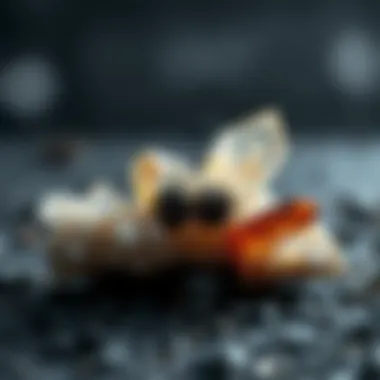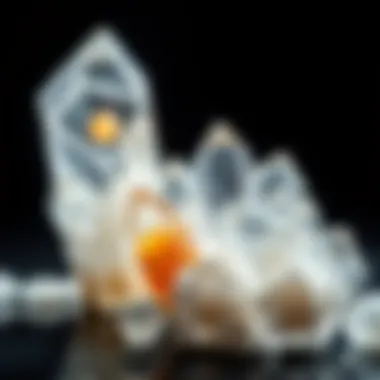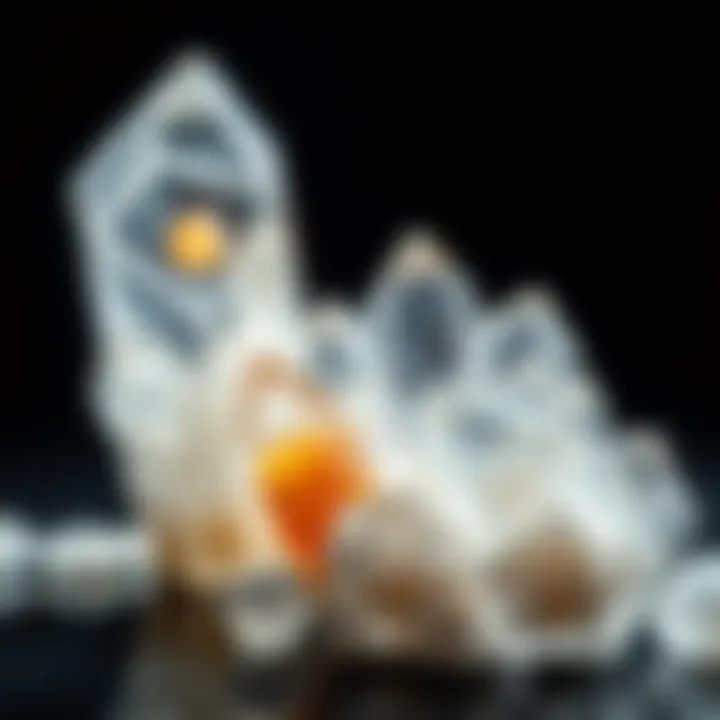Exploring the Diverse Types of Crystals


Intro
Crystals are more than just beautiful objects to behold; they are fascinating natural formations that tell the story of the earth’s geological history. These intriguing structures come in a multitude of colors, shapes, and sizes, each with its own unique characteristics and properties. From the majesty of amethyst to the simplicity of quartz, crystals offer a glimpse into the diverse processes that shape our planet.
The allure of crystals extends beyond their aesthetic appeal. They are often classified based on their formation processes and properties, making it crucial for both budding enthusiasts and seasoned collectors to understand the different categories. Whether you are searching for crystals for their alleged metaphysical properties, or simply as a hobby, understanding these classifications allows for informed choices in sourcing and caring for your collection.
In the upcoming sections, we’ll delve into the various types of crystals such as igneous, sedimentary, and metamorphic. We will also touch on more specialized categories, including organic and synthetic crystals. This exploration not only enriches our knowledge but further fosters appreciation for these timeless treasures.
Featured Collectible of the Month
Overview
This month, we shine a light on Selenite, a crystal known for its soft, pearly luster and translucent quality. Found primarily in Morocco and the USA, Selenite is often used in spiritual practices, as well as admired for its unique beauty. It can often be identified by its long, striated crystals which can resemble delicate rods or wands.
In the realm of crystal collecting, Selenite holds a special place due to its purported ability to cleanse other stones. This crystal has gained popularity among collectors and practitioners alike, making it a worthwhile addition to any collection.
Historical Significance
Used since ancient times, Selenite has been attributed with various properties across different cultures. The ancient Egyptians believed it to be a protective crystal and often used it in their burial rituals, placing pieces around tombs to keep malevolent spirits at bay. Furthermore, in ancient Rome, Selenite was used to craft decorative objects, showcasing its dual appeal of utility and beauty.
As collectors turn their attention to this remarkable crystal, they not only acquire a striking piece for their collection but also partake in a rich tapestry of history and tradition.
Identification Techniques
Visual Characteristics
When it comes to identifying crystals, Selenite offers distinct features that stand out:
- Color: Generally, it is a translucent white or colorless crystal, though some pieces may have a slight tint.
- Luster: Selenite has a pearly or glassy appearance, reflecting light in unique ways.
- Structure: It often forms in flat plates or elongated crystals with clear striations on their surface.
To differentiate Selenite from similar-looking crystals like gypsum, pay attention to its clarity and luster, which are often more pronounced.
Resources for Identification
For rock and fossil collectors looking to expand their knowledge base, several key resources offer insight into crystal identification:
- Mindat.org: A comprehensive mineral database containing information on many types of crystals.
- The International Gem Society (IGS): A valuable source for gemological education and crystal properties.
- Wikipedia: Often good for a general overview of different crystal types.
With these tips and resources in mind, collectors can refine their skills, successfully identifying and appreciating the unique characteristics of the crystals they encounter.
Prolusion to Crystals
Crystals have long fascinated humans, whether they lie sparkling in the earth or adorn our jewelry. The realm of crystals is not just about their beauty; it extends deeply into their formation, properties, and roles in technology and nature. In this article, we aim to peel back the layers of this captivating subject, diving into the complexity and richness that crystals encompass. Understanding crystals is not only fundamental for collectors but also crucial for anyone intrigued by geology, chemistry, and even spirituality.
At their core, crystals are solid materials whose atoms are arranged in highly ordered, repeating patterns. This geometric structure gives rise to various properties, affecting everything from their appearance and hardness to how they interact chemically. The importance of delving into the science of crystals is manifested in many real-world applications. From the intricate silicon crystals that power your gadgets to the naturally occurring minerals used in healing practices, the spectrum of crystal use is broad and significant.
Consideration of how these solid structures form lays the groundwork for comprehending the diverse types we will explore later. Environment plays a crucial role in this, influencing crystals' growth rates, shapes, and even colors. Therefore, recognizing these elemental factors not only enriches our understanding but also enhances our appreciation when identifying and discussing different types of crystals.
"Crystals are not merely beautiful objects; they are also the result of complex natural processes that reflect the Earth’s history."
Many individuals think of crystals simply as collectibles or decorative objects. However, the depth of their significance reaches well beyond aesthetics. Understanding crystals can lead the way to discovering how they can be harnessed for technological advancement, as well as psychological and emotional support. As we traverse into the intricacies of types, sources, and characteristics of crystals, it is essential to remember that each crystal tells a story—of formation, time, and transformation. Every quartz, amethyst, or diamond connects us to the earth in a tangible, physical way, highlighting the ties between nature and human endeavor. The journey into the lush diversity of pulses, patterns, and properties in this crystalline world is about to unfold, bringing both education and intrigue.
With that said, let’s embark on this intriguing journey, understanding not only the types of crystals but also the methods and environments that allow them to flourish.
The Science of Crystallization
Understanding the science of crystallization is crucial for appreciating the broader context of crystals in our world. The process offers insights into how various conditions lead to the formation of different types of crystals, which underscores their diverse properties and applications.
Crystallization is not merely an aesthetic phenomenon; it’s a fundamental process underlying many natural and synthetic materials. This section will explore the scientific principles that govern crystal formation and the significance of these principles in both geological and industrial contexts. By diving into this fascinating topic, we can better appreciate the intricacies of crystal development and formation, paving the way for deeper insights into their applications and roles in nature.
Defining Crystals
At their core, crystals are solid materials whose atoms are arranged in a highly ordered, repeating pattern. These geometric structures can take on various shapes, from cubes to hexagons, depending on the arrangement of atoms within them. When we think of crystals, common examples like diamond or quartz may spring to mind, each showcasing the beauty and diversity of these forms.
The defining characteristic of a crystal is its crystalline lattice, which tightly packs the atoms in a way that maximizes stability and minimizes energy. This ordered arrangement contrasts sharply with amorphous solids, which have no long-range order in their atomic structure. Thus, defining crystals requires an exploration of both their physical structure and the underlying atomic relationships.
How Crystals Form
Crystals can form from various processes, primarily involving the cooling of a liquid or evaporation of a gas. There are three main mechanisms of crystallization:
- Melt Crystallization: This occurs when molten substance cools down, allowing atoms to organize into a solid structure as temperature drops. A classic example is the formation of igneous rocks, where magma cools and crystallizes into distinct mineral structures.
- Solution Crystallization: In this instance, dissolved materials within a liquid medium crystallize as conditions change—such as temperature fluctuation or evaporation of the liquid. Rock salt, for instance, forms as seawater evaporates and leaves behind recrystallized minerals.
- Sublimation Crystallization: Here, a substance transitions directly from a gas to a solid without passing through a liquid state, which is common in some organic compounds and ice crystals in cold conditions.
Each method of formation can lead to a variety of crystal types, distinguished by their colors, shapes, and sizes. Such variations stem from the specific conditions present during formation—temperature changes, purification processes, and pressure levels all play substantial roles.
The Role of Environment in Crystal Formation
The environment is a key player in the crystallization process and can drastically influence the characteristics of the resulting crystals. Factors like temperature, pressure, and the presence of other chemicals can mold how crystals grow and evolve. For instance, in high-pressure conditions, gemstones like sapphires and rubies develop their distinct traits; likewise, some minerals may only form under very specific environmental conditions.


Moreover, impurities can introduce noticeable changes in color and texture to the crystals. This phenomenon, known as "solid solution," occurs when foreign atoms occupy positions in the crystal lattice. For example, the varied colors seen in quartz can be traced back to the presence of iron or other minerals during its formation.
"The unique characteristics of crystals are often a direct reflection of their environmental conditions and atomic interactions."
In summary, every facet of crystal formation—from the atomic scale to broader ecological interactions—plays a critical role in determining how these natural wonders manifest.
Ultimately, gaining a deeper understanding of the science behind crystallization enriches our appreciation of these extraordinary structures and brings clarity to their diverse range of applications in our everyday lives.
Types of Crystals
Understanding Types of Crystals plays a significant role in revealing the fascinating diversity found in this subgroup of minerals. Crystals are notable not just for their beauty, but for their varied structural forms and physical properties. Each type possesses unique characteristics stemming from how it is formed and the bonds that hold its atoms together. This classification is paramount for several reasons.
- Scientific Insight: Knowing the differences gives insights into their chemical composition and physical behavior, which is crucial for various applications.
- Collecting and Valuing: For enthusiasts and collectors alike, recognizing crystal types impacts their value and desirability in the market.
- Application Diversity: Different crystals are suited for specific applications, ranging from industrial to decorative purposes.
As we delve deeper into these types, we will explore ionic, covalent, metallic, and molecular crystals, each having its own story to tell.
Ionic Crystals
Ionic crystals crystallize from the electrostatic forces between positively and negatively charged ions. A classic example of ionic crystals is sodium chloride, or table salt. The formation process generally involves the transfer of electrons, leading to the creation of charged ions. The strength of these ionic bonds leads to the high melting and boiling points characteristic of ionic crystal structures.
- Properties:
- High melting points
- Soluble in water
- Conduct electricity when dissolved in water or molten
This makes ionic crystals critical in both natural and synthetic realms. In nature, they can be found abundantly, while in industries, they are used in making various compounds including fertilizers.
Covalent Crystals
Covalent crystals, also known as network solids, comprise atoms that share electrons through covalent bonds. One prominent example is diamond, which is renowned for its hardness and brilliance. The continuous network of bonds allows these crystals to exhibit unique properties, like exceptional strength and high melting points. This bonding structure leads to properties such as:
- Properties:
- Very high melting points
- Strong and durable
- Poor electrical conductivity
Covalent crystals are significant not only for their use in jewelry but also in industrial applications. Their robustness found a niche in cutting tools and abrasives, showing that beauty often walks hand-in-hand with functionality.
Metallic Crystals
Metallic crystals consist of metal cations surrounded by a sea of delocalized electrons that can move freely. This structure accounts for many typical properties of metals, such as luster, malleability, and electrical conductivity. Consider copper, a prime example of a metallic crystal. This malleable metal is used extensively in electrical wiring due to its excellent conductive properties.
- Properties:
- Good electrical and thermal conductivity
- Malleable and ductile
- Shiny appearance
The presence of metallic bonds allows these crystals to withstand deformation without breaking, making them versatile in various applications across industries ranging from electronics to construction.
Molecular Crystals
Molecular crystals are distinct in that they are formed from molecules held together by intermolecular forces, including van der Waals forces and hydrogen bonds. An example here is sugar, whose crystalline form is a sweet testament to the beauty of molecular structures. These crystals tend to have lower melting points compared to their ionic and covalent counterparts because their bonds are weaker.
- Properties:
- Lower melting points
- Often soft and brittle
- Generally poor electrical conductors
Molecular crystals have intrigued researchers in various fields, including biology and food science. They play a vital role in the stability of enzymes and other biological components, showing that even the simplest of structures can have profound implications.
"In the realm of crystals, each type serves a special purpose, marrying beauty and structure in ways that influence both nature and human endeavor."
These four types of crystals illustrate a vast world of differences—each stemming from varied bonding types and structural implications. Understanding these distinctions not only enhances the appreciation of these formations but also equips collectors and enthusiasts with essential knowledge for their pursuits.
Mineral Crystals
Mineral crystals are the backbone of geology, playing a crucial role in the makeup of the Earth's crust and the very foundation of many rocks. Their importance in this article stems not just from their beauty and diversity, but also from their geological significance. Each type of mineral crystal offers insight into the environmental conditions during its formation, ranging from the heat and pressure of volcanic activity to the slow, methodical processes of sedimentation. Understanding mineral crystals gives collectors an edge not only in acquiring beautiful specimens but also in appreciating the stories behind them.
The benefits of exploring mineral crystals extend beyond mere aesthetic pleasure. These crystals can have practical applications in various fields such as manufacturing, technology, and even medicine. For instance, quartz, a common silicate mineral, is widely used in electronics for its piezoelectric properties. Knowing what types of mineral crystals exist allows collectors and enthusiasts to make informed decisions when it comes to acquisition and care.
Given the intricate ways in which these crystals form, consideration must be given to the specific conditions that yield each type. Collectors keen on looking for authenticity will find that understanding the formation process can help distinguish genuine specimens from imitations.
Silicate Crystals
Silicate crystals are perhaps the most prevalent and diverse group found in nature. They are characterized by the presence of silicon and oxygen, making up an astonishing 95% of the Earth's crust. This category includes familiar minerals such as quartz, feldspar, and mica, which not only dominate igneous rocks but also appear in sedimentary and metamorphic types.
Quartz, a prominent representative of silicate crystals, is famed for its hardness and clarity. It can be found in many forms, including amethyst and smoky quartz, often sought after by collectors for its varied hues and shapes.
Understanding silicate crystals can open a window into the geological history of a region, as their types and structures can reveal the conditions under which they formed. Through the study and collection of these crystals, enthusiasts can discern the narratives written in stone.
Carbonate Crystals
Carbonate crystals are widely recognized for their distinctive compositions, primarily featuring carbonate ions (CO3) in their structure. This group includes minerals like calcite and aragonite, which are not just aesthetically pleasing but also significant from a geological perspective.


These crystals often form in sedimentary environments, particularly in marine settings. Collectors may find carbonate crystals fascinating not only for their radiant colors but also for their role in understanding past oceanic conditions. The presence of certain colors or bands within these crystals can signal specific environmental changes.
Oxide Crystals
Oxide crystals arise from the combination of oxygen with other metallic elements. Commonly known examples are hematite and corundum, the latter being the source of rubies and sapphires. These crystals are essential in various industrial processes, including metallurgy and electronics.
The distinctive properties of oxide crystals make them a topic of interest for both material scientists and collectors. Many oxide crystals exhibit unique light-reflecting properties, leading them to be favored in cutting-edge technology and even jewelry. Knowing their industrial applications further enhances the value they hold for collectors.
Sulfide Crystals
Sulfide crystals stand out due to the presence of sulfur in their chemical composition. This group includes familiar minerals like pyrite, commonly known as fool's gold, and chalcopyrite, which are often sought after for their metallic luster and economic value.
The study of sulfide minerals is crucial for mining and economic geology, as they often indicate the presence of valuable ores. Collectors are drawn to these crystals not only for their beauty but also for their potential implications related to mineral exploration and resource extraction.
Understanding the chemical properties of sulfide crystals can enrich a collector's approach, enabling them to grasp the economic and geological significance of their specimens.
Organic Crystals
Organic crystals play a significant role in the realm of crystallography and the natural sciences. Unlike mineral crystals, which form from inorganic processes, organic crystals emerge from biological activities. This distinction underlines their uniqueness, both in formation and application. Understanding organic crystals is essential as they can offer insights into biological processes, ecological interactions, and the fusion of natural and synthetic materials.
The conversation around organic crystals isn’t just for scientists or collectors; it’s also relevant to industries like pharmaceuticals and materials science. These crystals can have medical applications or serve as building blocks for new materials, making them invaluable in various fields.
Moreover, organic crystals’ fascinating composition reflects the diverse biochemical environments from which they arise. Their study can lead to breakthroughs in research areas such as biochemistry and environmental science, allowing scientists to unravel the complexities of life at a molecular level.
Organic crystals are not merely drop-in replacements for their inorganic cousins; they possess distinct characteristics that can influence their applicability in real-world scenarios.
In examining their properties, we discover that organic crystals often exhibit lower melting points and different optical properties compared to inorganic crystals, opening doors to innovative uses in technology and materials engineering.
Biogenic Crystals
Biogenic crystals, a subset of organic crystals, are induced by biological processes. These crystals typically form within living organisms, displaying an incredible range of diversity. Shellfish, for instance, create calcium carbonate crystals to form their shells. Similarly, our own bones contain hydroxyapatite crystals, showcasing how life utilizes crystallization for structural integrity.
The formation of these crystals often involves intricate interactions between organic molecules and minerals, resulting in a highly specialized lattice structure. This process is often influenced by environmental factors, such as temperature and pressure, emphasizing the adaptability of life forms.
The significance of biogenic crystals can be observed in several noteworthy applications:
- Biomineralization: This helps understand how minerals interact with biological systems, which is crucial for fields like geology and paleontology.
- Medical research: Studying biogenic crystals aids in the development of better drug delivery systems and understanding disease mechanisms.
- Environmental monitoring: These crystals can indicate the health of ecosystems, as their presence often reflects specific environmental conditions.
Synthetic Organic Crystals
On the other hand, synthetic organic crystals arise from human intervention, often engineered in laboratories to serve specific purposes. Their creation involves chemical synthesis processes that mimic natural crystal formation. While these synthetic creations may mirror their natural counterparts in structure, they can be specifically tailored to enhance desired properties such as solubility, stability, or hardness.
In many cases, synthetic organic crystals represent the intersection of chemistry and engineering. Scientists manipulate molecular interactions to create these crystals, paving the way for innovation in manufacturing and technology. Here are some areas where synthetic organic crystals find relevance:
- Pharmaceuticals: Many drugs are developed as organic crystal forms to improve efficacy and bioavailability.
- Technology: Organic crystals are utilized in electronic devices and sensors, benefiting from their unique conductive properties.
- Research: They provide researchers with the ability to study crystallization processes and improve sustainability in material development.
Gemstones: A Specialized Category
Gemstones hold a unique place in the world of crystals, and not just because of their aesthetic appeal. They entice collectors and jewelry enthusiasts alike, offering insight into geological processes and human craftsmanship. This section aims to shed light on the distinguishing features of gemstones, their significance, and the various aspects that make them a specialized category within the broader spectrum of crystals.
Precious vs. Semi-Precious Stones
When diving into the realm of gemstones, a common discussion centers on the classification of stones as either precious or semi-precious. Precious stones include diamonds, rubies, sapphires, and emeralds—these are often valued for their rarity and remarkable properties.
On the flip side, semi-precious stones like amethyst, citrine, and garnet, while less costly, can exhibit stunning qualities as well. The terms themselves can be misleading; some semi-precious stones may be rarer than precious ones depending on market trends and availability.
- Precious stones:
- Semi-precious stones:
- Diamonds
- Rubies
- Sapphires
- Emeralds
- Amethyst
- Citrine
- Garnet
- Aquamarine
The terminology can often influence purchasing decisions, yet true collectors often seek out the stories and characteristics each stone brings, regardless of its label.
The Formation of Gem Crystals
The genesis of gemstone crystals is a fascinating subject. Unlike your everyday rocks, gemstones develop under conditions favorable for crystallization. For instance, diamonds are formed deep within the Earth’s mantle under incredibly high pressure and temperature. On the other hand, a stone like opal forms from the evaporation of water rich in silica.
Here are some formation processes that create gemstones:
- Metamorphism: Changes in existing rocks due to heat and pressure can give rise to new mineral structures, yielding gems like garnet.
- Igneous processes: Magma cools and solidifies to form minerals; for instance, tourmaline can be found in granitic rocks.
- Sedimentary processes: This involves the accumulation of minerals from dissolved states, as seen in stones like quartz.
The journey from formation to being discovered and cut into gemstones is intricate, making each specimen a blend of natural history and human effort.
Gemstone Classification
Gemstones can be classified based on several criteria, ranging from geological origin to color and crystal structure. A primary classification in geology is whether they are formed from minerals or organic materials.
- Mineral gemstones: Most gemstones fall into this category, where the stone is made from minerals like quartz or talc.
- Organic gemstones: These are derived from once-living organisms. For example, pearls and amber are considered organic gems, showcasing how life contributes to the world of crystals.


In addition to mineralogical classifications, gemstones can also be categorized by their optical properties:
- Transparency: Clear stones like diamonds, versus opaque stones like turquoise.
- Color: This is often the most recognized property, as color variety can influence desirability significantly.
- Luster: The way a stone reflects light can differentiate it further, adding to the beauty and appeal.
Understanding the classification of gemstones not only enriches the experience of collecting but also fosters an appreciation for the diverse processes that create these elegant formations.
Applications of Crystals
The practical uses of crystals extend far beyond sheer aesthetics. As remarkable structures arising from the orderly arrangement of molecules, their applications touch various facets of modern life. For rock and fossil collectors, understanding these applications enriches one’s appreciation of crystals, revealing the intricate relationship between natural phenomena and technological advancements. With industries leveraging the properties of crystals, the benefits arising from these natural wonders present intriguing avenues for exploration.
Crystals find applications across several fields, each capitalizing on specific characteristics. From the shimmering clarity of quartz in electronics to the robust nature of diamond in cutting tools, it is evident that the diverse types of crystals contribute significantly to both everyday items and specialized equipment. Below, we will dive into industrial uses, technological advancements, and the fascinating realm of holistic healing, illustrating the multifaceted role of crystals in society.
Industrial Uses of Crystals
In industry, crystals hold significant sway due to their unique physical properties. For instance, the piezoelectric effect observed in certain crystals like quartz enables it to convert mechanical energy into electrical energy. This property is harnessed in various applications including:
- Transducers: These devices convert one form of energy to another. They are widely utilized in microphones, speakers, and ultrasound equipment.
- Frequency Control: Quartz crystals are essential in watches and radios for controlling frequency, ensuring accurate timekeeping and communication.
Another prime example involves diamond, often referred to as the hardest natural material. Its extraordinary toughness makes it invaluable in the manufacturing sector for:
- Cutting Tools: Diamond-tipped blades and drill bits enhance precision in machining processes.
- Abrasives: Used in grinding and polishing applications, diamond abrasives maintain effective performance across various substrates.
Understanding these industrial uses allows collectors to see crystals not just as collectibles but also as entities that underpin modern manufacturing and technology, bringing value beyond the visual appeal.
Crystals in Technology
The intersection of crystals and technology showcases an ever-evolving relationship, displaying how integral they are to contemporary life. Take, for example, liquid crystals, found in screens of modern smartphones and TVs. Liquid crystal displays (LCDs) rely on the manipulation of light passing through the layered arrangement of liquid crystals to produce visual images. Crystals also play a pivotal role in:
- Optical Components: Many optical devices such as lasers, lenses, and prisms utilize crystal optics to enhance performance and precision.
- Photonics: The ability to manipulate photons (light particles) in crystals leads to innovations in telecommunications and information technology.
As technology advances, the role of crystals only expands, pushing boundaries in how we perceive and interact with information daily. The next time you check your watch or flip through a digital screen, remember that the humble crystal is silently powering the magic.
Healing Properties of Crystals
In addition to their tangible applications in products and industry, many believe that crystals possess metaphysical properties. The idea that certain crystals can contribute to healing aligns closely with ancient practices and holistic medicine. Though science may view these claims with skepticism, the cultural significance is profound. Some popular healing crystals include:
- Amethyst: Often associated with tranquility, it's believed to aid in stress reduction and promote restful sleep.
- Rose Quartz: Known as the stone of love, it is thought to encourage emotional healing and enhance relationships.
- Citrine: This crystal is seen as an energizer, meant to enhance motivation and bring positivity.
"The energy emitted by crystals is said to promote balance and well-being, acting as a bridge between physical and emotional health."
For collectors, understanding these beliefs is essential as they can influence both the market value and the emotional connection people have with their crystals. Each crystal tells a story, steeped in layers of meaning that go beyond mere beauty.
Collecting Crystals
Collecting crystals is more than just a hobby; it’s a deep dive into the beauty and complexity of the natural world. With each stone, you're not just acquiring a piece of the Earth, but you're also connecting with its history, chemistry, and the artistry that nature creates over millions of years. This section illuminates the significance of collecting crystals, the specific elements to consider, the myriad benefits it offers to both novice and veteran enthusiasts, and the thoughtful approach necessary for a successful collection.
The allure of crystals can often be likened to that of art—each stone has its own unique story, spin, and aesthetic. Whether you’re drawn in by the shimmering facets of a quartz or the deep, rich hue of an amethyst, there's a certain magic in how these collected pieces can personalize one's living space or work environment.
Starting a Crystal Collection
For those starting out, it’s best not to dive head-first into the collection. Patience is valuable, and having a plan can save you a heap of regret down the line. Begin with the basics: understanding what type of crystals resonate with you. This is often influenced by color, texture, and perceived metaphysical properties.
Here are some key points to kick off:
- Research and Study: Familiarize yourself with various types of crystals. Read books, follow forums on platforms like reddit.com, and join local clubs where you can learn from other collectors.
- Set a Budget: Crystals can be pricey, especially rare ones. Determine how much you're willing to spend and stick to that budget to avoid impulsive purchases that could drain your wallet.
- Start Small: Maybe begin with common stones like amethyst or rose quartz before expanding to rarer varieties. This not only makes it easier to collect, but also allows you to gauge your interest without emptying your pockets.
Identifying Authentic Crystals
Identifying authentic crystals is crucial for any collector. Fake crystals are readily available and can be difficult to distinguish from the real deal. Here are some tell-tale signs that can help you spot a genuine crystal:
- Weight and Density: Genuine crystals often feel heavier for their size compared to glass or plastic imitations.
- Clarity and Refraction: Hold the crystal up to a light source. Authentic crystals should have unique refraction patterns, while fakes might look too perfect without any natural imperfections.
- Surface and Texture: Look out for natural chips or inclusions which add character. If a crystal feels oddly smooth or flawless, it might not be genuine.
"Collecting crystals isn’t just acquiring pretty stones; it's about appreciating the magnificence of nature and its geological history."
Care and Preservation of Crystals
Once you’ve built your collection, it's crucial to think about how to care for and preserve your crystals. These beautiful geological wonders require proper handling to maintain their integrity. Here are some strategies to keep them in tip-top shape:
- Cleaning: Use lukewarm soapy water for most crystals. However, some stones (like selenite) should never be submerged. Instead, gently wipe them with a damp cloth.
- Storage: Keep each crystal in a soft pouch or a dedicated display case to avoid scratches. A dark place is often best to prevent fading due to sunlight exposure.
- Regular Check-Ups: Make it a regular practice to inspect your collection. Look for any signs of wear, and take note of any that might need extra care or restoration.
In the realm of rocks and fossils, a well-curated crystal collection can become not just a collection of stones but a cherished documentation of both personal preference and nature's artistry. Each piece tells a story, and the care taken to preserve them further enriches that tale.
Ending
In wrapping up this exploration of crystals, it's vital to reflect on the multifaceted nature of these remarkable structures. Crystals are not just beautiful, but they hold significant value in multiple realms, ranging from industry to metaphysical practices. Their diverse types—ranging from ionic to organic—indicate the vast spectrum of their formation, uses, and the conditions under which they thrive.
One key takeaway from this journey is the understanding that the environment plays a crucial role in the formation of crystals. This is where the temperature, pressure, and chemical composition all come into play. For instance, while searching for geodes, a collector might stumble upon a hidden treasure formed under precise conditions, thus reinforcing the appreciation for nature’s intricate workings.
Aside from the physical appeal, crystals also capture the imagination of collectors and enthusiasts alike. For rock and fossil collectors, these formations often symbolize patience, as some can take thousands of years to develop. Collectors don’t just acquire pieces; they cultivate stories and connections through their journeys in search of unique specimens.
Moreover, in understanding the applications of crystals—from technological advances to possible healing properties—one can see their evolving relevance in our contemporary lives. The science of crystals encourages not just appreciation of their beauty, but also opens doors to innovative applications.
"Crystals are not silent; they resonate with the energies of nature, embodying both time and life."
Ultimately, this article has aimed to present a comprehensive guide about crystals, providing valuable knowledge to foster curiosity and motivation for both new enthusiasts and seasoned professionals. As you delve deeper into this fascinating subject, keep in mind that each crystal carries its own story, waiting to be explored. The world of crystals is indeed a mosaic of life, waiting for you to uncover its layers, one facet at a time.



